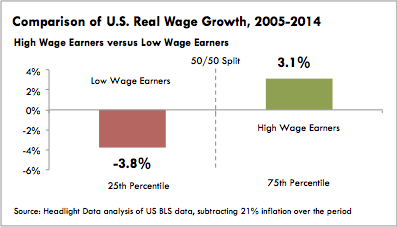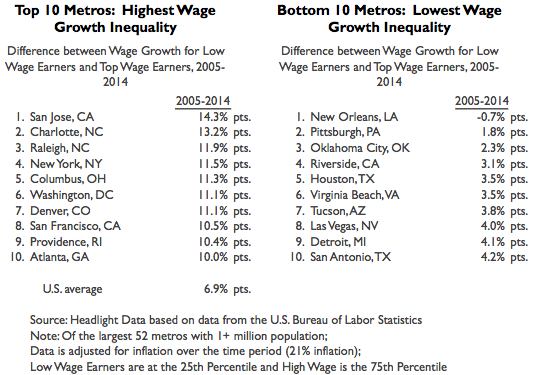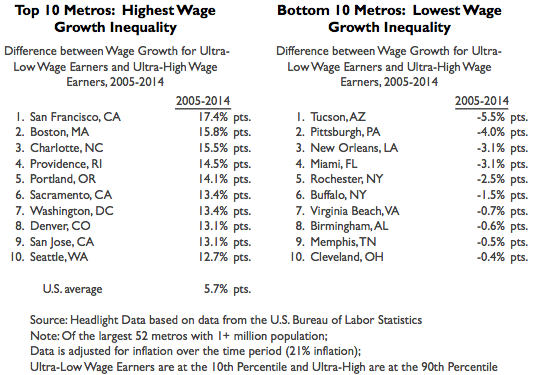22 Oct 2015 Wage Growth Inequality Grows in the U.S.; Is Highest in San Jose, Charlotte and Raleigh; Lowest in New Orleans, Pittsburgh, Oklahoma City
Wage growth inequality can be defined as the difference between the growth in wages for two different levels of wage earners.
Workers are split between “High Wage” earners and “Low Wage” earners. High Wage earners are those in the top half of the chart below and have a median wage at the 75th Percentile. Low Wage earners have a median wage at the 25th Percentile. The difference in median wage growth from 2005-2014 of these two groups is an indication of whether inequality has gotten better or worse over time.
Overall for the US, High Wage earners enjoyed a 3.1% increase in their real median wage, after accounting for inflation. Low Wage earners witnessed a 3.8% fall in their wage. Across the 52 largest U.S. metros (with 1+ million population), the highest wage growth inequality over the 2005-2014 period was in San Jose (a 14 percentage point difference in growth rates), followed by Charlotte (13 percentage pts.) and Raleigh (12 percentage pts.).
All large US metros experienced wage growth inequality that favored High Wage earners, with the exception of New Orleans. Pittsburgh and Oklahoma City also had minimal wage growth inequality. Examining the extremes of the spectrum, the Ultra-High Wage earners (90th Percentile) versus the Ultra-Low Wage earners (10th Percentile), wage growth inequality was worst in San Francisco, Boston, and Charlotte. The least was found in Tucson, Pittsburgh, and New Orleans.
Click here to download a spreadsheet of the data.
Research, analysis and content developed by Headlight Data. Original data from the U.S. Bureau of Labor Statistics’ Occupational Employment Estimates program.
About Headlight Data:
Headlight Data is an award-winning online data aggregator, designed for economic and workforce development organizations, that provides online, decision-support tools on the economy, demographics, education, workforce and public policy.
U.S. Real Median Wage Shows No Increase Since 2005; Highest Wage Growth Found in New Orleans, Pittsburgh, and DC; High-Wage Earners Did Best in San Jose; Low-Wage Earners Did Best in New Orleans
The real median wage in the U.S. has not increased from 2005 to 2014, falling ... Read more
Baton Rouge, Charleston, Provo see Largest Growth in Median Wage For Mid-Sized Metros Since 2005; Youngstown Wage Declined the Most
As described in a previous article for large metros, wage performance can be examined at ... Read more



